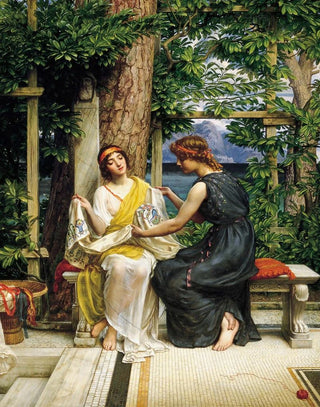Art print | Hélène and Hermia - Edward John Poynter


View from behind

Frame (optional)
In the vast panorama of art history, certain works stand out for their ability to capture moments of beauty and emotion. "Hélène et Hermia," painted by Edward John Poynter, belongs to this privileged category. This piece, which evokes themes of love, mythology, and feminine beauty, transports the viewer into a universe filled with delicacy and poetry. The depiction of Hélène, an iconic figure of Greek mythology, and Hermia, a character from Shakespeare's comedy, invites us to explore the complexities of human relationships across ages. Poynter's mastery in the use of color and light creates an enchanting atmosphere, where every detail seems to pulse with its own life.
Style and uniqueness of the work
Poynter's style is characterized by meticulous attention to detail and a realistic approach that transcends mere visual rendering. In "Hélène et Hermia," the female figures are portrayed with grace and elegance that reflect the aesthetic ideal of the Victorian era. The composition is carefully orchestrated, with flowing lines guiding the viewer's gaze through the piece. The drapery of the characters' clothing, rendered with remarkable precision, adds a tactile dimension to the painting. The colors, both vibrant and harmonious, evoke a dreamlike atmosphere, where light plays a crucial role, illuminating the faces of the protagonists and creating delicate shadows that enhance the depth of the image. This work does not merely depict mythological figures; it tells a story, that of love and choices, while celebrating beauty in all its forms.
The artist and his influence
Edward John Poynter, a British painter of the 19th century, established himself as a key figure in the Pre-Raphaelite movement. His training at the Royal Academy of Arts and his travels across Europe, notably in Italy, profoundly influenced his artistic approach. Poynter distinguished himself by his ability to combine tradition and innovation, borrowing elements from classicism while incorporating contemporary themes. His

Matte finish

View from behind

Frame (optional)
In the vast panorama of art history, certain works stand out for their ability to capture moments of beauty and emotion. "Hélène et Hermia," painted by Edward John Poynter, belongs to this privileged category. This piece, which evokes themes of love, mythology, and feminine beauty, transports the viewer into a universe filled with delicacy and poetry. The depiction of Hélène, an iconic figure of Greek mythology, and Hermia, a character from Shakespeare's comedy, invites us to explore the complexities of human relationships across ages. Poynter's mastery in the use of color and light creates an enchanting atmosphere, where every detail seems to pulse with its own life.
Style and uniqueness of the work
Poynter's style is characterized by meticulous attention to detail and a realistic approach that transcends mere visual rendering. In "Hélène et Hermia," the female figures are portrayed with grace and elegance that reflect the aesthetic ideal of the Victorian era. The composition is carefully orchestrated, with flowing lines guiding the viewer's gaze through the piece. The drapery of the characters' clothing, rendered with remarkable precision, adds a tactile dimension to the painting. The colors, both vibrant and harmonious, evoke a dreamlike atmosphere, where light plays a crucial role, illuminating the faces of the protagonists and creating delicate shadows that enhance the depth of the image. This work does not merely depict mythological figures; it tells a story, that of love and choices, while celebrating beauty in all its forms.
The artist and his influence
Edward John Poynter, a British painter of the 19th century, established himself as a key figure in the Pre-Raphaelite movement. His training at the Royal Academy of Arts and his travels across Europe, notably in Italy, profoundly influenced his artistic approach. Poynter distinguished himself by his ability to combine tradition and innovation, borrowing elements from classicism while incorporating contemporary themes. His






